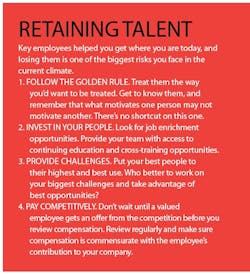Builders face a host of risks in the course of doing business, including production stoppage, budget variances, liability associated with jobsite accidents, governmental compliance, and quality defects, to name a few. If unmanaged, these risks can sink you. But by developing a work culture that focuses on people and processes, risks can be managed.
Setting the Tone: Leading by Example
Developing a company culture that focuses on people begins at the top, but it’s a goal that must be shared by each level of management. It takes time and requires consistency and trust. Leaders at all levels must provide regular, open, and honest communication. Involve and empower employees, trades, and suppliers to achieve shared goals.
Align words and actions. There needs to be consistency between what you say and what you do. Demonstrate frugality on the jobsite and you’re in a better position to expect the same from trades and suppliers. Show a strong work ethic by arriving first to work in the morning and leaving last in the evening and you’re more likely to get others to put in the hours needed to hit a tough closing date. It’s one of the most effective ways that leaders earn the respect of those around them.Be accessible and available. Leading by example often manifests itself in what people see. But what they hear is also important. Open, honest, and frequent communication means sharing company objectives and current events on a regular basis. It’s letting people know that you want to hear about the risks out there.
You also need to make it clear that you want recommendations on the best way to manage risks. Company meetings, departmental meetings, employee portals, and notices that employees see when they log in are all avenues for sharing information.
Make sure that communication and message dovetail. For example, if a conversation about better communication is beneficial, face-to-face interaction is more effective than sharing a memo in a newsletter or posting it to a company employee website or on a bulletin board.
Clearly define roles, accountability, and authority. Involved and empowered employees and trades are essential to managing risks. But empowerment has to come with ground rules. Builders should define job functions and roles, individual accountability, and decision-making authority so that each member of their team knows what they can and can’t do. Make it clear that some issues, such as safety, quality, and governmental compliance, are everyone’s responsibility. (Yes, some companies may have full-time positions dedicated to managing these risks, but the person in that role can’t be everywhere at once.)
Emphasize that safety is everyone’s job. Unmitigated risk is seeing an issue and doing nothing about it. Conversely, the person who believes safety, quality, or government compliance is everybody’s job and then sees a hazardous situation, observes a quality defect being constructed, or sees an OSHA, EPA, or other requirement being ignored is more likely to intervene and correct the situation before it becomes a bigger problem.
Use recognition as a team-building tool. When someone observes a risk and takes action to prevent it from becoming a problem, be sure to acknowledge him or her. When you recognize people for doing well, it motivates them to do more.
Early in my career, a mentor told me that it was my job as a leader to “catch someone doing something right and thank them for it.” That advice has stuck with me ever since. Appreciation goes a long way. Celebrate your company’s success with the people who helped make that success a reality. Consider including your key suppliers and trades in the celebration. The more they feel a part of the team, the more they will choose your firm over the competition when labor is tight. This is also a good example of how a focus on people can mitigate a labor shortage risk.
An Engaged Team Can Sharpen Best Practices
Focusing on people is important—and it’s just the start. With an engaged team, a builder can further manage risk by developing processes that are best practices for the builder’s environment.
Involve those closest to the process. Best practices are often best developed by enlisting the individuals who actually perform the job. This is essential for efficiency; a good process will prevent employees from reinventing the wheel every time they execute a task. A good process that’s followed will provide consistency. Documented processes are also a great tool for new-employee orientation and training. It’s imperative that documented processes be kept up to date. An outdated process can be just as harmful as no process at all.
Leverage know-how across teams. Cross-functional process improvement teams can be assembled for assignments that range from meeting customer requirements to reducing warranty costs, cycle times, and construction costs to improving quality. Such teams can reduce costs and manage risks at the commodity level. These commodity teams can be made up of employees from purchasing at a corporate, regional, and divisional level for large production builders.
Cross-functional teams should also include a representative from construction and resources from sales, warranty, and accounting. The resources are typically involved just as needed to address a specific issue. However, the purchasing and construction members of the team work together to identify opportunities to reduce costs while also implementing cost avoidance strategies.
Take advantage of knowledge from varied markets, too. Any builder that works in multiple regions needs to tap the knowledge base of its teams in various locations.
Don’t forget suppliers and trades. They can enhance cross-functional teams. Involve them early in the design process to ensure sound construction, warranties, cost management, and continuous improvement—this can save a lot of mistakes down the road. Your framer can tell you that a specific floor plan will be labor-intensive while providing you with a list of things you can do to reduce the labor required. An HVAC contractor can review the plans and tell you where the problem areas are (e.g., LVL preventing duct run). Other trades and suppliers that are good resources during the design process include pro dealers (lumberyards), foundation companies, plumbers, cabinet and countertop companies, flooring companies, and electricians.
A Process Improvement Team Can Help Lead
One of the biggest opportunities to manage risk is to have a cross-functional team that reviews new plan designs and plan changes. The team should include (at a minimum) the architect, structural engineer, pro dealer, framer, HVAC contractor, and folks from purchasing, sales, construction, and, if applicable, the design studio.
By developing a culture that focuses on people and processes, risks can be managed. It’s not easy, but leaders at all levels need to lead by example; provide regular, open, honest communication; and involve as well as empower employees, trades, and suppliers to achieve shared goals. The old TEAM adage, “Together Everyone Achieves More,” rings especially true when it comes to mitigating risk.
About the Author

Tony Callahan
Tony L. Callahan, CPSM, CSCP, has worked in the home building industry for nearly two decades and is an expert in purchasing and supply chain management.


